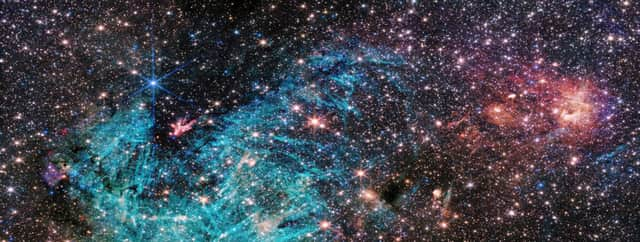Young cluster: James Webb Telescope captures half a million stars forming in the Milky Way


The James Webb Space Telescope (JWST or Webb telescope) has once again stunned us with its imagery after it snaps a picture of our Milky Way galaxy in a way we have never seen before.
The photo shows, in magnificent detail, 500,000 stars densely packed together in a glittering blue hue after its NIRCam (Near-Infrared Camera) instrument was able to pick up a 50 light-years-wide portion of the Milky Way’s dense centre.
Advertisement
Hide AdAdvertisement
Hide Ad“There's never been any infrared data on this region with the level of resolution and sensitivity we get with Webb,” said the observation team’s principal investigator Samuel Crowe, an undergraduate student at the University of Virginia in Charlottesville.
“Massive stars are factories that produce heavy elements in their nuclear cores, so understanding them better is like learning the origin story of much of the universe. So, we are seeing lots of features here for the first time. Webb reveals an incredible amount of detail, allowing us to study star formation in this sort of environment in a way that wasn’t possible previously.”
He added: “The Webb has provided us with a ton of data on this extreme environment, and we are just starting to dig into it. The image from Webb is stunning, and the science we will get from it is even better."
The photo shows the galactic centre of the Milky Way which is where new stars form - which is an instance environment has it involves the collision of gases. “The galactic centre is the most extreme environment in our Milky Way galaxy, where current theories of star formation can be put to their most rigorous test,” Professor Jonathan Tan, one of Crowe’s advisors at the University of Virginia said.
Advertisement
Hide AdAdvertisement
Hide AdThe Webb Telescope has been used as a way to peer into the deepest depth of our universe as it has pictured some spectacular images from across the universe. But this star formation is just 25,000 light-years from Earth.
Nasa says at the heart of this young cluster is a previously known, massive protostar over 30 times the mass of our Sun. The cloud the protostars are emerging from is so dense that the light from stars behind it cannot reach Webb, making it appear less crowded when in fact it is one of the most densely packed areas of the image. Smaller infrared-dark clouds dot the image, looking like holes in the starfield - that’s where future stars are forming.
Rubén Fedriani, a co-investigator of the project at the Instituto Astrofísica de Andalucía in Spain also highlighted how vigorous the galactic center is. He said: “The galactic centre is a crowded, tumultuous place. There are turbulent, magnetized gas clouds that are forming stars, which then impact the surrounding gas with their outflowing winds, jets, and radiation."
Comment Guidelines
National World encourages reader discussion on our stories. User feedback, insights and back-and-forth exchanges add a rich layer of context to reporting. Please review our Community Guidelines before commenting.
